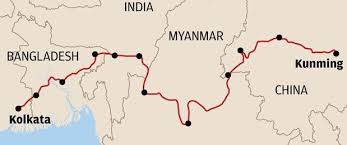What is the issue?
- Sheikh Hasina won the recent general election in Bangladesh, starting her third continuous term as the Prime Minister.
- With this recent development, it is essential to note the structural change unfolding in Bangladesh and its long-term implications.
How has Hasina's Bangladesh been?
- Over the last decade, there has been a dramatic improvement in the country’s economic prospects.
- The stability and continuity provided by Hasina have been critical for this transformation.
- Under her leadership, Bangladesh has emerged as one of the world’s fastest-growing economies.
- Its per capita income has doubled over the last decade.
- It is all set to leave the category of “least developed countries”.
- Hasina aims to accelerate the annual economic growth rate from the current 7% to nearly 10% by 2021 when Bangladesh celebrates its 50th birthday.
What does the transformation mean for the Subcontinent?
- Economy - The growth has begun to change the economic hierarchy in the region, by displacing Pakistan in the second spot.
- The per capita income of Bangladesh, $1800, is now larger than that of Pakistan’s at about $1600.
- The aggregate GDP ($275 bn) is geared to overtake Pakistan’s at $310 bn in the coming years.
- In contrast to international scepticism about Pakistan’s economic future, there is optimism about Dhaka’s economic prospects.
- Pakistan - The traditional Pakistani condescension towards Bangladesh is yielding to a measure of admiration for Bangladesh.
- There are demands to adopt the “Bangladesh model”, focussing on economic development rather than political adventurism.
- There are also calls for promoting religious moderation instead of extremism.
- China - Bangladesh is also critical for the success of China's plans to integrate its Yunnan province with Myanmar, Bangladesh and eastern India.
- Unlike the China-Pakistan Economic Corridor, India has only fewer problems with the BCIM (Bangladesh-China-India-Myanmar) corridor.

- Myanmar - The maritime territorial issues with India and Myanmar have been peacefully resolved through arbitration.
- This facilitates maritime economic and security cooperation within the Bay of Bengal.
- This, in turn, would deepen the integration between eastern Subcontinent and Southeast Asia.
- South Asia - Bangladesh's rise alters the balance within South Asia by tilting the economic centre of gravity towards the east.
- The economic advancement of Bangladesh helps lift up the whole of the eastern Subcontinent.
- It includes India’s Northeast as well as Bhutan and Nepal.
- Geography has positioned both Pakistan and Bangladesh as natural “bridge states”.
- Pakistan (Rawalpindi) has chosen destabilisation of its neighbours through cross-border terrorism and insurgencies.
- On the other hand, Dhaka has chosen the path of regional cooperation, utilising the geographic potential.
- It was Dhaka’s initiative that helped found the SAARC in the mid-1980s.
- But the SAARC remains dysfunctional due to Pakistan’s reluctance to engage in economic cooperation with India.
- Nevertheless, the consequence has been the fillip to sub-regional cooperation in the eastern Subcontinent involving Bangladesh, Bhutan, India and Nepal.
- Equally important has been the re-vitalisation of the BIMSTEC forum.
- It is pursuing trans-regional cooperation between five South Asian countries (Bangladesh, Bhutan, India, Nepal and Sri Lanka) and two Southeast Asian countries (Myanmar and Thailand).
- In all, with the rise of Bangladesh and the expanding regional cooperation centred around it, there is a positive future for the whole of the subcontinent.
Source: Indian Express
